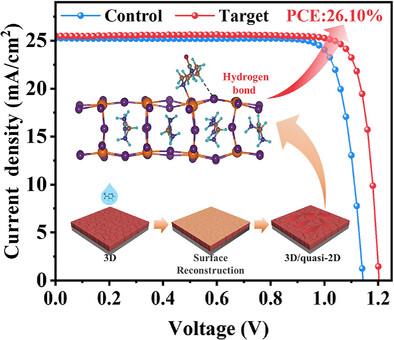Reconstruction of the Surface for Efficient 3D/Quasi-2D Heterostructured Inverted Perovskite Solar Cells
IF 19
1区 材料科学
Q1 CHEMISTRY, MULTIDISCIPLINARY
引用次数: 0
Abstract
Energy level misalignment-induced interfacial non-radiative recombination and interface defect-induced carrier transport loss are key factors limiting the power conversion efficiency (PCE) of perovskite solar cells. To address these issues, this work introduces 3-Piperidinecarboxamide (PDN) to reconstruct the surface of the 3D perovskite. PDN passivates both shallow and deep defects simultaneously, forming an n-type quasi-2D perovskite surface layer that enhances electron extraction and reduces the energy level barrier. Density functional theory (DFT) calculations reveal that the electron donor unit (R-C-NH) of PDN preferentially binds to undercoordinated Pb2+ defects sites on the perovskite (PVK) surface. The hydrogen bonding formed between the R-NH2 group of PDN and I− ions on the [PbI6]4− octahedra enhances the above binding capability. The device adopting this strategy achieves a champion PCE of 26.10%. Furthermore, unencapsulated PSCs also exhibits excellent stability, retaining 88% of the initial PCE retained after ≈1400 h at 25 °C under 30% humidity.

高效三维/准二维异质结构倒置钙钛矿太阳能电池的表面重建
能级失调引起的界面非辐射复合和界面缺陷引起的载流子输运损失是制约钙钛矿太阳能电池功率转换效率的关键因素。为了解决这些问题,本研究引入了3-哌啶甲酸酰胺(PDN)来重建三维钙钛矿的表面。PDN同时钝化了浅缺陷和深缺陷,形成了n型准二维钙钛矿表面层,增强了电子提取,降低了能级势垒。密度泛函理论(DFT)计算表明,PDN的电子给体单元(R-C-NH)优先结合钙钛矿(PVK)表面欠配位的Pb2+缺陷位点。PDN的R-NH2基团与[PbI6]4 -八面体上的I -离子之间形成的氢键增强了上述结合能力。采用这种策略的设备实现了26.10%的冠军PCE。此外,未封装的PSCs也表现出优异的稳定性,在25°C、30%湿度下≈1400小时后,PCE的保留率为初始PCE的88%。
本文章由计算机程序翻译,如有差异,请以英文原文为准。
求助全文
约1分钟内获得全文
求助全文
来源期刊

Advanced Functional Materials
工程技术-材料科学:综合
CiteScore
29.50
自引率
4.20%
发文量
2086
审稿时长
2.1 months
期刊介绍:
Firmly established as a top-tier materials science journal, Advanced Functional Materials reports breakthrough research in all aspects of materials science, including nanotechnology, chemistry, physics, and biology every week.
Advanced Functional Materials is known for its rapid and fair peer review, quality content, and high impact, making it the first choice of the international materials science community.
 求助内容:
求助内容: 应助结果提醒方式:
应助结果提醒方式:


